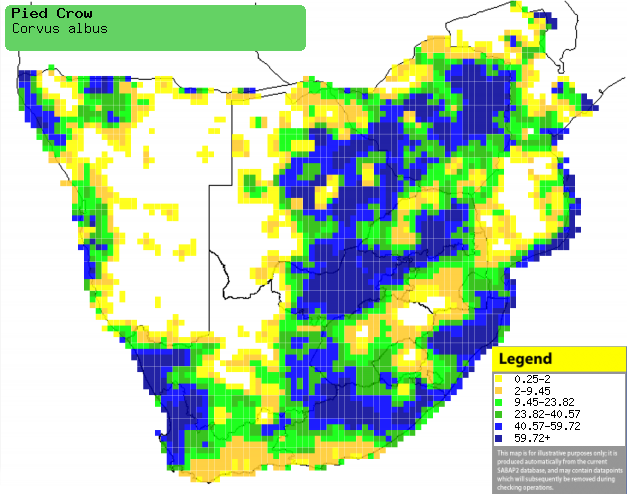|
Corvus albus (Pied crow)
Witborskraai [Afrikaans]; Igwangwa, Igwarhube [Xhosa];
iGwababa, uGwabayi [Zulu]; Ekorova (generic term for crows) [Kwangali];
Mohakajane [South Sotho]; Legokobu [North Sotho]; Gunguwo [Shona]; Lihubhulu
[Swazi]; Qigwana [Tsonga]; LegakabÍ [Tswana]; Schildraaf [Dutch]; Corbeau pie
[French]; Schildrabe [German]; Gralha-seminarista [Portuguese]
Life
> Eukaryotes >
Opisthokonta
> Metazoa (animals) >
Bilateria >
Deuterostomia > Chordata >
Craniata > Vertebrata (vertebrates) > Gnathostomata (jawed
vertebrates) > Teleostomi (teleost fish) > Osteichthyes (bony fish) > Class:
Sarcopterygii (lobe-finned
fish) > Stegocephalia (terrestrial
vertebrates) > Tetrapoda
(four-legged vertebrates) > Reptiliomorpha > Amniota >
Reptilia (reptiles) >
Romeriida > Diapsida > Archosauromorpha > Archosauria >
Dinosauria
(dinosaurs) > Saurischia > Theropoda (bipedal predatory dinosaurs) >
Coelurosauria > Maniraptora > Aves
(birds) >
Order: Passeriformes > Family: Corvidae
Distribution and habitat
Occurs across sub-Saharan Africa, absent only from areas of
Somalia and Ethiopia, as well as much of eastern Botswana, the Northern Cape and
western Namibia. It has become prolific, as its numbers and range are expanding
especially in the Karoo. It often occupies savanna woodland and bushy
shrubland, but it is becoming more and more common in farmland, urban and
suburban areas.
|
 |
|
Distribution of Pied crow in southern Africa,
based on statistical smoothing of the records from first SA Bird Atlas
Project (©
Animal Demography unit, University of
Cape Town; smoothing by Birgit Erni and Francesca Little). Colours range
from dark blue (most common) through to yellow (least common).
See here for the latest distribution
from the SABAP2. |
Brood parasites
It has been recorded as host of the
Great spotted cuckoo.
Food
It is omnivorous, feeding mainly on plant material such as
fruit and seeds, doing most of its foraging on the ground. It also regularly
eats animals, such as reptiles, fish, insects, small mammals and birds. In one
observation, it caught and ripped apart a small bird in mid flight. It also
takes eggs and even whole nests from breeding pairs of smaller birds. Reptiles
are mainly taken from the ground (especially when crossing roads) and it may
even attack fruit bats at their roosting site. The following food items have
been recorded in its diet:
- Plants
- fruit
- Scaevola plumieri (Seoplakkie)
- Opuntia ficus-indica (Prickly pear)
- Atriplex semibaccata (Creeping saltbush)
- seeds
- cereal crops (e.g. maize)
- Elaeis guineensis (Oil palm)
- nectar
- Aloe marlothi (Mountain aloe)
- Animals
- Invertebrates
- Reptiles
- Mammals
- Amblysomus hottentotus (Hottentot golden mole)
- Georychus capensis (Cape mole-rat)
- Rhabdomys pumilio (Striped mouse)
- bats
- fruit bats
- Eptesicus capensis (Cape serotine bat)
- Birds
Breeding
- Both sexes construct the nest, which is a large bowl made of twigs,
sometimes including bits of wire and lined with fur, dry dung, rags or sheep
wool. It is usually placed in the vertical fork of a tall tree, such as a
pine, Eucalyptus, cypress or palm. It also commonly places it on the
top of a telegraph pole, especially in more open areas, such as the Karoo.
- It lays 1-7, usually 4 eggs, which are mainly incubated by the female
for about 18-19 days.
- In one observation, the female solely foraged for the young, bringing
them about 3 food items per hour. They eventually left the nest after 38
days.
Threats
Not threatened, in fact widespread and prolific.
References
-
Hockey PAR, Dean WRJ and Ryan PG 2005. Roberts
- Birds of southern Africa, VIIth ed. The Trustees of the John Voelcker
Bird Book Fund, Cape Town.
|
